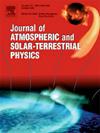Developing machine learning models for predicting daily relative humidity and solar radiation using lagged time series data inputs in a semi-arid climate
IF 1.9
4区 地球科学
Q3 GEOCHEMISTRY & GEOPHYSICS
Journal of Atmospheric and Solar-Terrestrial Physics
Pub Date : 2025-09-03
DOI:10.1016/j.jastp.2025.106619
引用次数: 0
Abstract
Estimating relative humidity and solar radiation is crucial for understanding their impact on the hydrological cycle, which in turn affects water resource availability and distribution. Accurately predicting these variables is challenging due to their non-linear behaviour. Machine learning (ML) techniques have attracted significant attention for addressing such complex non-linear problems. In this study, the prediction of relative humidity and solar radiation for ICAR-IARI (Indian Council of Agricultural Research - Indian Agricultural Research Institute), New Delhi, India, under semi-arid climate, was performed using long-term data spanning 31 years (1990–2020) and developed machine learning models such as linear regression (LR), multilayer perceptron (MLP), sequential minimal optimization-support vector machine (SMO-SVM), additive regression (AR), and random forest (RF). The performance of these models was evaluated using various statistical metrics, including coefficient of determination (R2), Nash–Sutcliffe efficiency (NSE), index of agreement (d), mean absolute error (MAE), root mean squared error (RMSE), relative absolute error (RAE), relative root squared error (RRSE) and mean absolute percentage error (MAPE). The results indicated that for relative humidity prediction, the RF model yielded the best results during training and testing periodswith statistical metrics R2, NSE, d, MAE, RMSE, RAE, RRSE and MAPE as 0.79, 0.40, 0.74, 6.31, 12.66, 54.62, 74.70 and 9.90, respectively during testing phase. The SMO-SVM model emerged as the best performer for solar radiation prediction, with performance metrics during the testing phase as follows: R2 = 0.89, MAE = 2.79, RMSE = 3.55, RAE = 52.54, RRSE = 59.59, NSE = 0.64, d = 0.88, and MAPE = 20.50. The findings of this study could be useful for developing and comparing relative humidity prediction models under different climatic conditions, using similar long-term data.
开发机器学习模型,用于在半干旱气候下使用滞后时间序列数据输入预测每日相对湿度和太阳辐射
估算相对湿度和太阳辐射对于了解它们对水文循环的影响至关重要,而水文循环反过来又影响水资源的可用性和分布。由于这些变量的非线性行为,准确预测它们是具有挑战性的。机器学习(ML)技术在解决这些复杂的非线性问题方面引起了极大的关注。本研究利用1990-2020年31年的长期数据,对印度新德里ICAR-IARI(印度农业研究委员会-印度农业研究所)在半干旱气候条件下的相对湿度和太阳辐射进行了预测,并开发了线性回归(LR)、多层感知器(MLP)、序列最小优化支持向量机(smoo - svm)、加性回归(AR)和随机森林(RF)等机器学习模型。采用各种统计指标,包括决定系数(R2)、Nash-Sutcliffe效率(NSE)、一致性指数(d)、平均绝对误差(MAE)、均方根误差(RMSE)、相对绝对误差(RAE)、相对均方根误差(RRSE)和平均绝对百分比误差(MAPE),对这些模型的性能进行评估。结果表明,RF模型在训练和测试阶段的相对湿度预测效果最好,测试阶段的统计指标R2、NSE、d、MAE、RMSE、RAE、RRSE和MAPE分别为0.79、0.40、0.74、6.31、12.66、54.62、74.70和9.90。SMO-SVM模型在太阳辐射预测中表现最好,其测试阶段的性能指标为:R2 = 0.89, MAE = 2.79, RMSE = 3.55, RAE = 52.54, RRSE = 59.59, NSE = 0.64, d = 0.88, MAPE = 20.50。这项研究的发现可能有助于开发和比较不同气候条件下使用类似长期数据的相对湿度预测模型。
本文章由计算机程序翻译,如有差异,请以英文原文为准。
求助全文
约1分钟内获得全文
求助全文
来源期刊

Journal of Atmospheric and Solar-Terrestrial Physics
地学-地球化学与地球物理
CiteScore
4.10
自引率
5.30%
发文量
95
审稿时长
6 months
期刊介绍:
The Journal of Atmospheric and Solar-Terrestrial Physics (JASTP) is an international journal concerned with the inter-disciplinary science of the Earth''s atmospheric and space environment, especially the highly varied and highly variable physical phenomena that occur in this natural laboratory and the processes that couple them.
The journal covers the physical processes operating in the troposphere, stratosphere, mesosphere, thermosphere, ionosphere, magnetosphere, the Sun, interplanetary medium, and heliosphere. Phenomena occurring in other "spheres", solar influences on climate, and supporting laboratory measurements are also considered. The journal deals especially with the coupling between the different regions.
Solar flares, coronal mass ejections, and other energetic events on the Sun create interesting and important perturbations in the near-Earth space environment. The physics of such "space weather" is central to the Journal of Atmospheric and Solar-Terrestrial Physics and the journal welcomes papers that lead in the direction of a predictive understanding of the coupled system. Regarding the upper atmosphere, the subjects of aeronomy, geomagnetism and geoelectricity, auroral phenomena, radio wave propagation, and plasma instabilities, are examples within the broad field of solar-terrestrial physics which emphasise the energy exchange between the solar wind, the magnetospheric and ionospheric plasmas, and the neutral gas. In the lower atmosphere, topics covered range from mesoscale to global scale dynamics, to atmospheric electricity, lightning and its effects, and to anthropogenic changes.
 求助内容:
求助内容: 应助结果提醒方式:
应助结果提醒方式:


